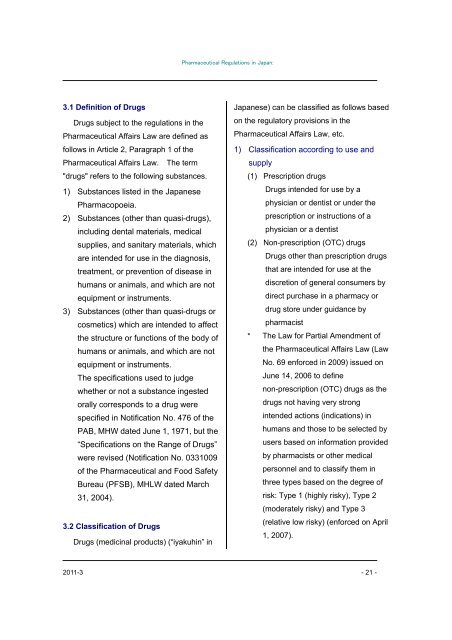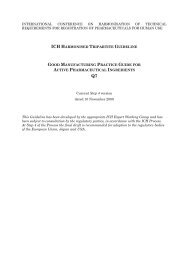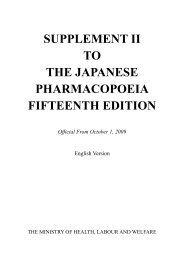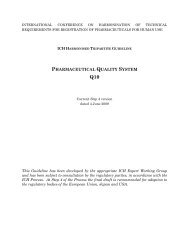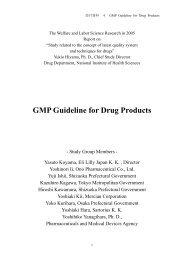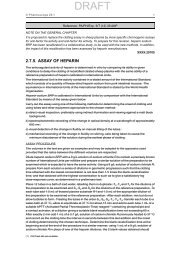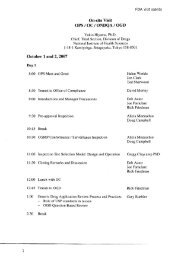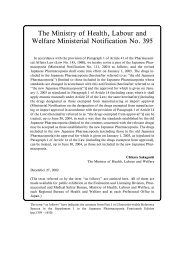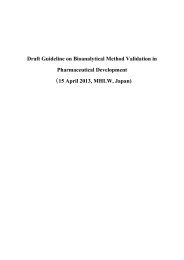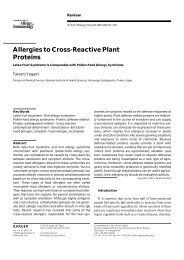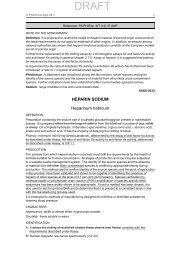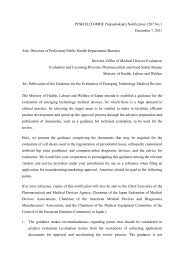Pharmaceutical Administration and Regulations in Japan - Nihs
Pharmaceutical Administration and Regulations in Japan - Nihs
Pharmaceutical Administration and Regulations in Japan - Nihs
You also want an ePaper? Increase the reach of your titles
YUMPU automatically turns print PDFs into web optimized ePapers that Google loves.
3.1 Def<strong>in</strong>ition of Drugs<br />
Drugs subject to the regulations <strong>in</strong> the<br />
<strong>Pharmaceutical</strong> Affairs Law are def<strong>in</strong>ed as<br />
follows <strong>in</strong> Article 2, Paragraph 1 of the<br />
<strong>Pharmaceutical</strong> Affairs Law. The term<br />
"drugs" refers to the follow<strong>in</strong>g substances.<br />
1) Substances listed <strong>in</strong> the <strong>Japan</strong>ese<br />
Pharmacopoeia.<br />
2) Substances (other than quasi-drugs),<br />
<strong>in</strong>clud<strong>in</strong>g dental materials, medical<br />
supplies, <strong>and</strong> sanitary materials, which<br />
are <strong>in</strong>tended for use <strong>in</strong> the diagnosis,<br />
treatment, or prevention of disease <strong>in</strong><br />
humans or animals, <strong>and</strong> which are not<br />
equipment or <strong>in</strong>struments.<br />
3) Substances (other than quasi-drugs or<br />
cosmetics) which are <strong>in</strong>tended to affect<br />
the structure or functions of the body of<br />
humans or animals, <strong>and</strong> which are not<br />
equipment or <strong>in</strong>struments.<br />
The specifications used to judge<br />
whether or not a substance <strong>in</strong>gested<br />
orally corresponds to a drug were<br />
specified <strong>in</strong> Notification No. 476 of the<br />
PAB, MHW dated June 1, 1971, but the<br />
“Specifications on the Range of Drugs”<br />
were revised (Notification No. 0331009<br />
of the <strong>Pharmaceutical</strong> <strong>and</strong> Food Safety<br />
Bureau (PFSB), MHLW dated March<br />
31, 2004).<br />
3.2 Classification of Drugs<br />
Drugs (medic<strong>in</strong>al products) (“iyakuh<strong>in</strong>” <strong>in</strong><br />
<strong>Pharmaceutical</strong> <strong>Regulations</strong> <strong>in</strong> <strong>Japan</strong>:<br />
<strong>Japan</strong>ese) can be classified as follows based<br />
on the regulatory provisions <strong>in</strong> the<br />
<strong>Pharmaceutical</strong> Affairs Law, etc.<br />
1) Classification accord<strong>in</strong>g to use <strong>and</strong><br />
supply<br />
(1) Prescription drugs<br />
Drugs <strong>in</strong>tended for use by a<br />
physician or dentist or under the<br />
prescription or <strong>in</strong>structions of a<br />
physician or a dentist<br />
(2) Non-prescription (OTC) drugs<br />
Drugs other than prescription drugs<br />
that are <strong>in</strong>tended for use at the<br />
discretion of general consumers by<br />
direct purchase <strong>in</strong> a pharmacy or<br />
drug store under guidance by<br />
pharmacist<br />
* The Law for Partial Amendment of<br />
the <strong>Pharmaceutical</strong> Affairs Law (Law<br />
No. 69 enforced <strong>in</strong> 2009) issued on<br />
June 14, 2006 to def<strong>in</strong>e<br />
non-prescription (OTC) drugs as the<br />
drugs not hav<strong>in</strong>g very strong<br />
<strong>in</strong>tended actions (<strong>in</strong>dications) <strong>in</strong><br />
humans <strong>and</strong> those to be selected by<br />
users based on <strong>in</strong>formation provided<br />
by pharmacists or other medical<br />
personnel <strong>and</strong> to classify them <strong>in</strong><br />
three types based on the degree of<br />
risk: Type 1 (highly risky), Type 2<br />
(moderately risky) <strong>and</strong> Type 3<br />
(relative low risky) (enforced on April<br />
1, 2007).<br />
2011-3 - 21 -


